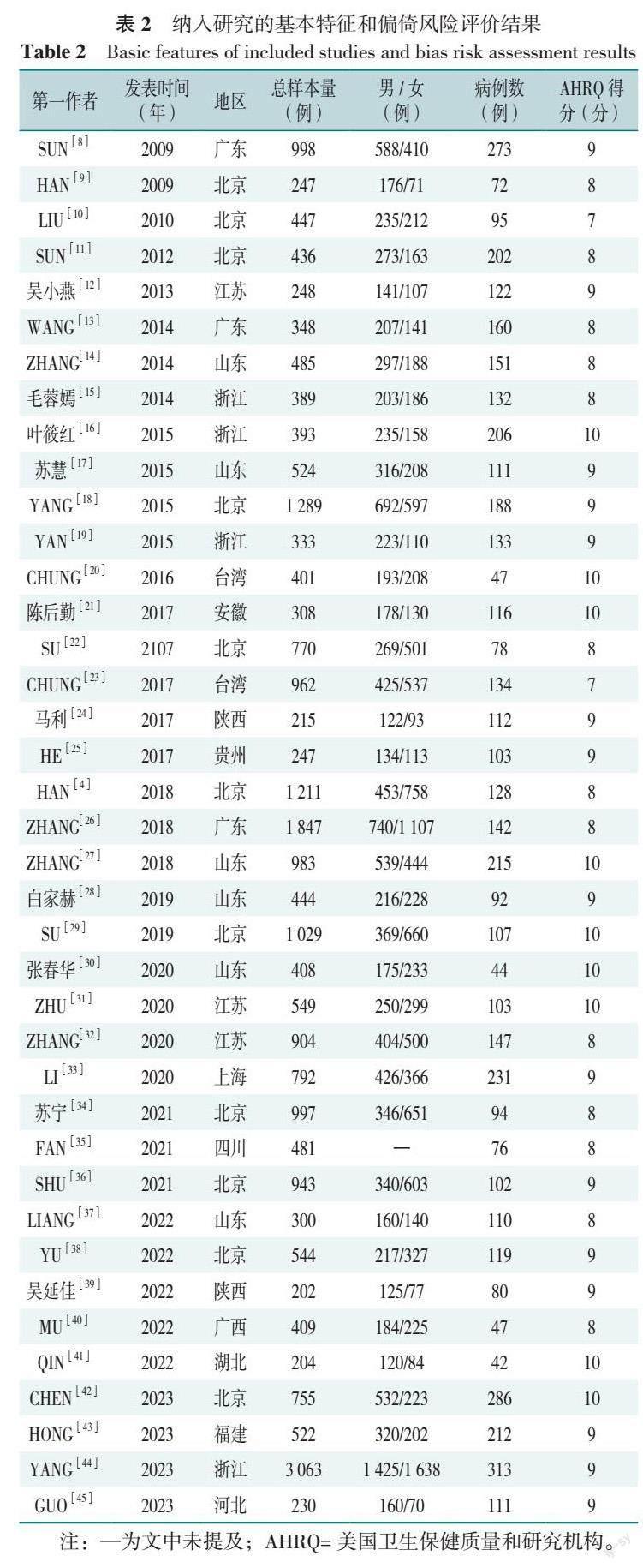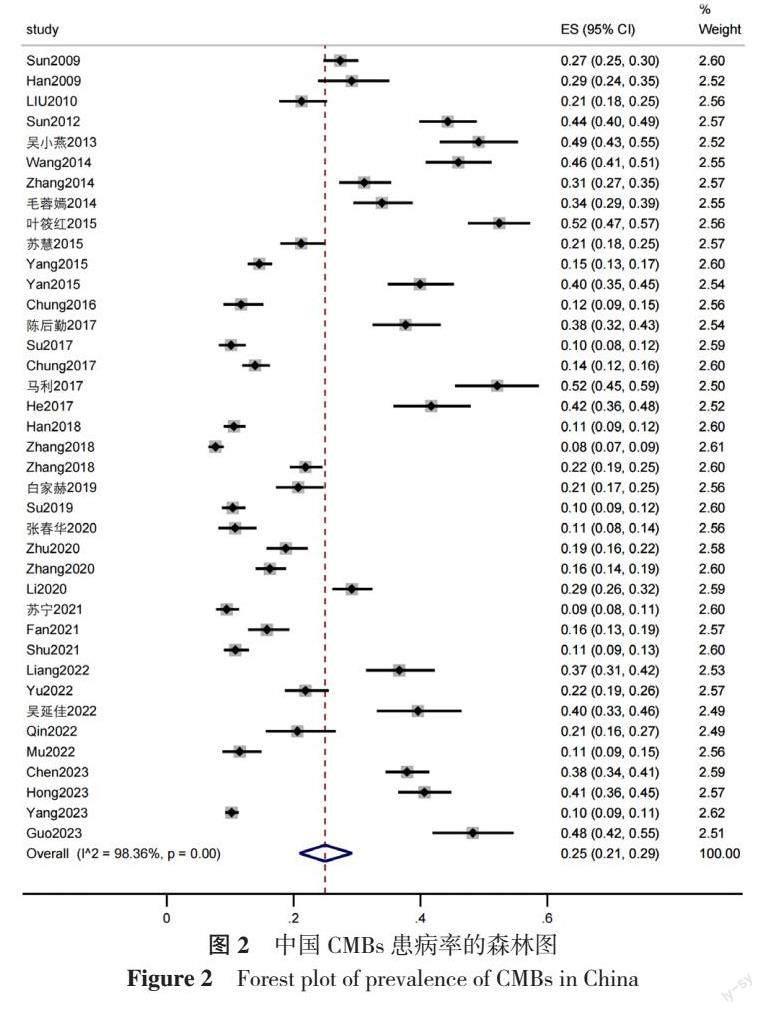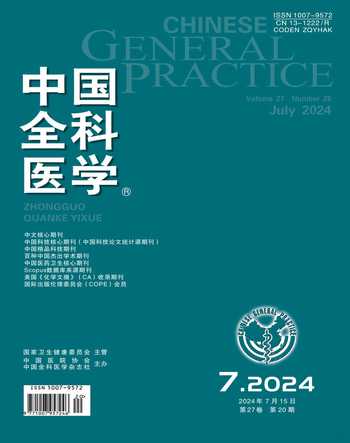中国人群脑微出血患病率的Meta分析
先丽红 李娟 薛超 赵雪姣 卢婷 颜欢



【摘要】 背景 腦微出血(CMBs)是严重危害我国国民健康的重要疾病,其发病率与年龄呈正相关。同时,CMBs也是卒中复发及诱发出血性脑卒中的独立危险因素。了解CMBs的患病现状对于推动我国健康老龄化进程及加强脑卒中防治工作具有重大现实意义。目的 系统评价我国CMBs发生的现况,为推进我国健康老龄化进程及加强脑卒中防治工作提供数据支撑。方法 系统检索中国生物医学文献数据库(CBM)、中国知网(CNKI)、万方数据知识服务平台(Wanfang Data)、维普网(VIP)、PubMed、Embase、Web of Science等数据库中有关我国CMBs患病率的横断面研究,检索时限为建库至2023年11月。2名研究者分别对文献进行筛选、资料提取及纳入文献的偏倚风险评估,并采用Stata 16.0软件进行Meta分析。结果 共纳入39项研究,25 877例研究对象。Meta分析结果显示:我国CMBs的总体患病率为25.0%(95%CI=21.0%~29.0%)。亚组分析结果显示,51~60、61~70、71~80岁CMBs患病率分别为27.0%(95%CI=12.0%~44.0%)、23.0%(95%CI=16.0%~30.0%)、27.0%(95%CI=20.0%~35.0%);男、女性CMBs患病率分别为14.0%(95%CI=11.0%~18.0%)、10.0%(95%CI=8.0%~12.0%);华北、华东、华南、华中、西南、西北地区CMBs患病率分别为21.0%(95%CI=15.0%~28.0%)、26.0%(95%CI=21.0%~33.0%)、21.0%(95%CI=8.0%~39.0%)、21.0%(95%CI=16.0%~27.0%)、24.0%(95%CI=21.0%~27.0%)、46.0%(95%CI=41.0%~51.0%);有、无高血压病史CMBs患病率分别为19.0%(95%CI=13.0%~26.0%)、8.0%(95%CI=6.0%~11.0%);有、无吸烟史CMBs患病率分别为9.0%(95%CI=5.0%~14.0%)、16.0%(95%CI=12.0%~21.0%)。结论 我国CMBs总体患病率较高,不同年龄分段、地域及省份之间存在明显差异。高龄、男性、西北地区以及有高血压病史的人群发病率较高。受纳入研究数量和质量限制,该结论亟待更多高质量研究证实。
【关键词】 脑微出血;患病率;中国;系统评价;Meta分析
【中图分类号】 R 743.34 【文献标识码】 A DOI:10.12114/j.issn.1007-9572.2023.0908
Prevalence for Cerebral Microbleeds in China:a Meta-analysis
XIAN Lihong1,LI Juan2*,XUE Chao3,ZHAO Xuejiao3,LU Ting3,YAN Huan1
1.Zunyi Medical University,Zunyi 563003,China
2.Nursing Department,Guizhou Provincial People's Hospital,Guiyang 550002,China
3.Nursing School of Guizhou University of TCM,Guiyang 550002,China
*Corresponding author:LI Juan,Professor/Chief superintendent nurse;E-mail:694807055@qq.com
【Abstract】 Background Cerebral microbleeds(CMBs)are important diseases that seriously endanger our national health,and their incidence is positively correlated with age. Meanwhile,CMBs are also an independent risk factor for stroke recurrence and induced hemorrhagic stroke. Understanding the current prevalence of CMBs is of great practical significance for promoting healthy aging and strengthening stroke prevention and treatment in China. Objective To systematically evaluate the current status of the occurrence of CMBs in China and to provide data support for promoting the process of healthy aging and strengthening the prevention and treatment of stroke in China. Methods Literature related to the occurrence of the disease of CMBs in our national population was systematically searched through Chinese and English databases such as CBM,CNKI,Wanfang Data,VIP,PubMed,Embase,and Web of Science,with a timeframe of the establishment of the database until November 2023 for all searches. Two researchers separately performed literature screening,data extraction,and evaluation of the risk of bias in the included literature,and meta-analysis was performed using Stata 16.0 software. Results A total of 39 studies were included,with a total of 25 877 study subjects. Meta-analysis showed that the overall incidence of CMBs in China was 25.0%(95%CI=21.0%-29.0%). The results of subgroup analysis showed that the prevalence was 27.0%(95%CI=12.0%-44.0%)for those aged 51-60 years,23.0%(95%CI=16.0%-30.0%)for those aged 61-70 years,and 27.0%(95%CI=20.0%-35.0%)for those aged 71-80 years;the prevalence was 21.0%(95%CI=15.0%-28.0%)in North China,26.0%(95%CI=21.0%-33.0%)in East China,21.0%(95%CI=8.0%-39.0%)in South China,21.0%(95%CI=16.0%-27.0%)in Central China,24.0%(95%CI=21.0%-27.0%)in Southwest China and 46.0%(95%CI=41.0%-51.0%)in Northwest China by geographic area;the prevalence of CMBs with a history of hypertension was 19.0%(95%CI=13.0%-26.0%)and without a history of hypertension was 8.0%(95%CI=6.0%-11.0%);the prevalence of CMBs with a history of smoking was 9.0%(95%CI=5.0%-14.0%) and without a history of smoking was 16.0%(95%CI=12.0%-21.0%). Conclusion The overall prevalence of CMBs in China is high,with significant differences between different age segments,regions,and provinces. Its prevalence was higher in people of advanced age,males,Northwest China,and nationals with a history of hypertension. Due to the limitations in both quantity and quality of the included studies,further confirmation of this conclusion through additional high-quality research is required.
【Key words】 Cerebral microbleeds;Prevalence rate;China;Systematic evaluation;Meta-analysis
脑微出血(cerebral microbleeds,CMBs)是脑小血管病(cerebral small vessel disease,CSVD)中的一个特殊亚型,是由多种因素导致的脑内小血管渗漏出血引起的脑实质亚临床损伤,其病变的脑小血管周围含有铁血黄素沉积是主要的病理特征[1]。CMBs发生时会引发血液分解和坏死物质的释放,进而引起老年急性脑梗死患者周围脑组织的水肿程度加重、颅内压升高,最终导致患者出现头晕、头痛和恶心等症状,严重时还会引发呼吸循环衰竭,威胁患者生命[2]。AKOUDAD等[3]对2008—2015年45岁以上的4 759名社区常住健康人群进行MRI筛查时发现,CMBs患病率为11.1%~18.7%。HAN等[4]研究显示,50~59岁人群CMBs患病率为7.6%,60~69岁上升至18.4%,70~80岁人群患病率高达24.8%。此外,有研究发现,CMBs被视为缺血性脑卒中再发和出血性脑卒中的独立危险因素,也是触发卒中后血管性认知功能障碍和情感障碍的关键因素[5]。由此可见,CMBs好发于老年人群中,对我国健康老龄化造成严重威胁。然而,国内尚缺乏有关CMBs患病率及发展趋势的综合报道。因此,本研究通过Meta分析的方法系统评价我国成年人CMBs发生情况,以期为我国CMBs的相关研究提供更加全面的数据支撑和参考依据,对推进我国健康老龄化和卒中防治工作也具有重大意义。
1 资料与方法
1.1 纳入与排除标准
1.1.1 研究类型:横断面研究。
1.1.2 研究对象:(1)在中国长期居住的人群(长期居住:持有常住户口或居住超过半年的人);(2)年龄≥18岁。
1.1.3 结局指标:CMBs患病率,CMBs为经影像学检查确诊后明确诊断。
1.1.4 排除指标:(1)研究数据重复或原始数据雷同;(2)非中、英文文献;(3)综述、会议及评论;(4)文献中的研究方案设计存在不合理之处或文献质量较低;(5)原始研究数据不全或无法获取;(6)样本量不少于200例。
1.2 文献检索策略
系统检索中国生物医学文献数据库(CBM)、中国知网(CNKI)、万方数据知识服务平台(Wanfang Data)、维普网(VIP)、PubMed、Embase、Web of Science等数据库中有关我国CMBs患病率的文献,文献检索时限均为建库至2023年11月。结合各数据库特点,使用主题词与自由词相结合的方式检索文献,并结合文献追踪技术获取具有研究意义的文献。英文检索词包括:Cerebral microbleeds,Cerebral microbleed,Cerebral microhemorrhages,Microbleed,microhemorrhage,CMBs,prevalence,Incidence,Occurrence,epidemi*,Chinese,China等。中文检索词包括:脑微出血、脑微出血灶、脑微出血病变、脑内微出血、患病率、现况调查、流行病学、调查等。以PubMed为例,具体检索策略见表1。
1.3 文献筛选和资料提取
由2名研究人员分别负责文献筛选和资料提取工作,并进行交叉验证以确保结果的准确性。若有分歧,可采取双方商议或邀请第三方介入进行讨论解决。文献筛选时,研究者先阅读文题剔除无关文献,再阅读摘要和全文,以确定是否采用。若有需要,可采取电子邮件和/或电话等方式与原始作者取得联系,征得作者同意后获取对本次研究至关重要但未报告的资料。提取资料包括:第一作者、发表时间、研究地点、确诊方式、总样本量、患病例数、年龄及相关数据等。
1.4 纳入研究的偏倚风险评价
纳入文献由2名研究者分别进行偏倚风险评价,在评价完成后进行交叉核对,旨在确保评估结果的准确性。若遇分歧,可采取双方商议或邀请第三方介入进行讨论解决。偏倚风险的评估是基于美国卫生保健质量和研究机构(Agency for Healthcare Research and Quality,AHRQ)所推荐的横断面研究偏倚风险评价准则而进行[6]。该工具共计11个条目,若每个条目评定为“是”则计1分,“否”或“不清楚”则计0分,其评定总分8~11分为高质量,4~7分为中等质量,0~3分为低质量[7]。
1.5 统计学方法
使用统计学软件Stata 16.0對我国CMBs患病率进行统计分析,采取双反正弦转换法对患病率进行转换合并计算,并提供其95%可信区间(CI)。使用χ2检验(检验水准α=0.1)和I2检验对研究的结果进行异质性分析。倘若研究结果间无统计学异质性,则选用固定效应模型进行Meta分析;倘若研究结果间有统计学异质性,则进一步分析异质性来源。在排除明显临床异质性影响后,采用随机效应模型进行Meta分析。Meta分析设定的水准为α=0.05。明显的临床异质性采用亚组分析进行处理,旨在进一步探讨影响CMBs发生的可能因素。
2 结果
2.1 文献筛选流程及结果
经初步筛选,共获得相关文献2 281篇。通过逐层筛选,最终纳入39篇文献[4,8-45],总样本量为25 877例。文献筛选流程图及结果见图1。
2.2 纳入研究的基本特征与偏倚风险评价结果
本研究纳入39项研究的基本特征与偏倚风险评价结果见表2。
2.3 Meta分析结果
2.3.1 总患病率:本研究纳入39项研究采取随机效应模型进行Meta分析,结果显示我国CMBs总患病率为25.0%(95%CI=21.0%~29.0%)(图2)。
2.3.2 亚组分析:按年龄、性别、地理区域、发表年份、有无高血压病史及吸烟史等类别进行亚组分析(表3)。
(1)按年龄分组,51~60岁CMBs患病率为27.0%(95%CI=12.0%~44.0%),61~70岁为23.0%(95%CI=16.0%~30.0%),71~80岁为27.0%(95%CI=20.0%~35.0%)。
(2)按性别分组,男性CMBs患病率为14.0%(95%CI=11.0%~18.0%),女性为10.0%(95%CI=8.0%~12.0%)。
(3)按地理区域分组,华北地区CBMs患病率为21.0%(95%CI=15.0%~28.0%),华东地区为26.0%(95%CI=21.0%~33.0%),华南地区为21.0%(95%CI=8.0%~39.0%),华中地区为21.0%(95%CI=16.0%~27.0%),西南地区为24.0%(95%CI=21.0%~27.0%),西北地区为46.0%(95%CI=41.0%~51.0%)。
(4)按发表年份分组,2009—2013年CMBs患病率为34.0%(95%CI=24.0%~44.0%),2014—2018年为26.0%(95%CI=19.0%~34.0%),2019—2023年为22.0%(95%CI=16.0%~27.0%)。
(5)按有无高血压病史分组,有高血压病史CMBs患病率为19.0%(95%CI=13.0%~26.0%),无高血压病史为8.0%(95%CI=6.0%~11.0%)。
(6)按有无吸烟史分组,有吸烟史CMBs患病率为9.0%(95%CI=5.0%~14.0%),无吸烟史为16.0%(95%CI=12.0%~21.0%)。
2.4 敏感性分析与发表偏倚检验
本研究采取逐一剔除研究法进行敏感性分析。结果表明效应量无显著变化,提示研究结果较稳定。
3 讨论
CMBs是一种亚临床性脑实质改变,源于正常或接近正常的脑组织中慢性血液产物的小病灶,因出血量较少,在临床上通常不伴有明显的症状和体征[46-47],易被忽视。有研究报道,CMBs发病率呈现显著的年龄依赖性增长趋势[48]。然而,目前尚无明确的CMBs治疗手段[49],这对我国健康老龄化来说是一个亟待关注的挑战。因此,本研究旨在对我国国人CMBs患病率进行系统评价,以明确CMBs在我国的流行状况,为我国CMBs的防治策略提供科学依据。
本研究汇总分析了39项横断面研究。其文献质量评价结果显示AHRQ评分为7~10分,其中高质量研究37项,中等质量研究2项,研究结果的可靠性得以保证。本研究Meta分析结果显示:我国CMBs总体患病率为25.0%,略低于CORICA等[50]的Meta分析结果28.3%,其原因可能与纳入研究的研究对象、地域环境、样本量和文化背景不同等因素有关。
本研究亚组分析结果显示:(1)从年龄分段来看,CMBs发病率会随着60岁以上人群的年龄增长而呈现上升趋势。QIN等[51]一项为期5年的队列研究发现,相较于青年人群,大脑萎缩的老年患者大脑脑叶性微出血的风险会增加2.6倍,表明年龄是CMBs的一个重要危险因素。LEE等[52]也证实高龄是CMBs的危险因素,可能与高龄相关的血管内皮功能紊乱有关[53]。(2)从患病史来看,有高血压病史人群的CMBs患病率远高于无高血压病史人群,与徐大飞等[54]研究结果一致。其原因可能是:①血管的自我调节功能随年龄增长及高血压的长期影响而逐渐衰退。颅内众多深穿支动脉对血压波动更为敏感,加之高龄导致胰岛素样生长因子分泌减少、羟基二十碳四烯酸介导通路受抑制,进而使血管平滑肌收缩功能减弱,诱发CMBs[55];②高血压可引发小动脉玻璃样变性,使血管平滑肌遭受纤维组织或坏死组织的替代。此外,随着年龄的增长,脑小动脉会出现萎缩,导致血管平滑肌细胞减少,脑小动脉更容易发生破裂,进而导致CMBs的发生[56]。(3)从有无吸烟史来看,有吸烟史人群的CMBs患病率比无吸烟史人群低。但相关研究认为吸烟是CMBs的独立危险因素[50,54],原因是吸烟会对人体的血管内皮细胞产生危害,而烟雾中的一氧化碳会与血液中的血红蛋白相结合形成碳氧血红蛋白,进而影响红细胞的携氧能力,导致组织缺氧,引起血管痉挛。此外,吸烟会增加血浆纤维蛋白原,引起凝血系统功能紊乱,从而诱发CMBs[57]。本研究的结果与既往研究结果存在争议,其原因可能与纳入研究的数量、质量和对吸烟的定义以及样本量等因素有关。(4)从性别分组来看,男性CMBs患病率高于女性,原因可能是男性的高血压患病率高于女性,而高血壓对CMBs发病机制起着一定的作用。因此,性别差异对CMBs的患病率也有一定的影响[56]。(5)从地理区域来看,西北地区患病率显著高于其他地区,这可能与地区医疗政策和发展情况、不同地区之间的生活习惯和文化差异等密切相关。因此,建议相关区域的卫生管理部门人员要重视该地人群CMBs的筛查及预防,这对我国卒中防治工作起着关键作用。
本次研究的样本量涵盖了中国大部分省份,能在一定程度上揭示我国CMBs患病率的分布状况。但该研究仍存在一定的局限性:(1)纳入的研究均为横断面研究,受研究设计、样本来源及大小等因素影响;(2)各研究间存在一定的异质性,虽在性别、年龄、地区等方面采取了亚组分析也未发现异质性来源;(3)部分亚组纳入的研究数量有限,其结果可靠性在一定程度上会有所降低;(4)个别分组在进行亚组分析时由于缺乏原始数据,其结果可能会存在偏倚。
综上所述,当前研究结果显示我国CMBs总体患病率较高,其患病率在男性、高龄、有高血压史及西北地区间表现得更为明显。因此,建议各级医疗机构应重点关注以上人群,发病率较高的地区医疗卫生机构要加强CMBs的筛查力度和政策关注,以降低我国CMBs的患病率,减轻我国医疗负担的同时也能减轻我国卒中防治工作负担。
作者贡献:先丽红负责文章构思与设计、数据收集与整理、论文撰写及修订;先丽红、薛超、赵雪姣负责文献检索、数据提取、质量评价及数据分析;先丽红、卢婷、颜欢负责结果的分析与解释;李娟负责文章审校及质量控制,并对文章整体负责。
本文无利益冲突。
PROSPERO注册号:CRD42023478793
参考文献
LITAK J,MAZUREK M,KULESZA B,et al. Cerebral small vessel disease[J]. Int J Mol Sci,2020,21(24):9729. DOI:10.3390/ijms21249729.
郝佳佳,周沛萱,丘惠嫦. 老年急性脑梗死患者并发脑微出血影响因素[J]. 中国老年学杂志,2022,42(21):5177-5180. DOI:10.3969/j.issn.1005-9202.2022.21.006.
AKOUDAD S,PORTEGIES M L,KOUDSTAAL P J,et al. Cerebral microbleeds are associated with an increased risk of stroke:the Rotterdam study[J]. Circulation,2015,132(6):509-516. DOI:10.1161/CIRCULATIONAHA.115.016261.
HAN F,ZHAI F F,WANG Q,et al. Prevalence and risk factors of cerebral small vessel disease in a Chinese population-based sample[J]. J Stroke,2018,20(2):239-246. DOI:10.5853/jos.2017.02110.
CHEN X D,WANG J H,SHAN Y L,et al. Cerebral small vessel disease:neuroimaging markers and clinical implication[J].
J Neurol,2019,266(10):2347-2362. DOI:10.1007/s00415-018-9077-3.
曾宪涛,刘慧,陈曦,等. Meta分析系列之四:观察性研究的质量评价工具[J]. 中国循证心血管医学杂志,2012,4(4):297-299. DOI:10.3969/j.1674-4055.2012.04.004.
唐萍,王佳琳,謝婉青,等. 中国老年人述情障碍发生现状的Meta分析[J]. 中国循证医学杂志,2021,21(7):779-786. DOI:10.7507/1672-2531.202103048.
SUN J,SOO Y O,LAM W W,et al. Different distribution patterns of cerebral microbleeds in acute ischemic stroke patients with and without hypertension[J]. Eur Neurol,2009,62(5):298-303. DOI:10.1159/000235850.
HAN J C,GAO P Y,LIN Y,et al. Three-tesla magnetic resonance imaging study of cerebral microbleeds in patients with ischemic stroke[J]. Neurol Res,2009,31(9):900-903. DOI:10.1179/174313209X382485.
LIU P F,CUI Y Z,NA J,et al. Cerebral microbleeds - prevalence,distribution and risk factors in northeast population without preceding large-area stroke[J]. Chin Med J,2010,123(3):286-290.
SUN S J,GAO P Y,SUI B B,et al. Association between cerebral microbleeds and the first onset of intracerebral hemorrhage - a 3.0 T MR study[J]. Acta Radiol,2012,53(2):203-207. DOI:10.1258/ar.2011.110463.
吴小燕,王少会,薛忠元,等. 脑梗死患者脑内微出血的发生及危险因素分析[J]. 中国慢性病预防与控制,2013,21(4):473-476. DOI:10.16386/j.cjpccd.issn.1004-6194.2013.04.041.
WANG B G,YANG N,LIN M,et al. Analysis of risk factors of hemorrhagic transformation after acute ischemic stroke:cerebral microbleeds do not correlate with hemorrhagic transformation[J]. Cell Biochem Biophys,2014,70(1):135-142. DOI:10.1007/s12013-014-9869-8.
ZHANG J B,J? X H,WANG J,et al. Serum cystatin C and cerebral microbleeds in patients with acute cerebral stroke[J]. J Clin Neurosci,2014,21(2):268-273. DOI:10.1016/j.jocn.2013.04.014.
毛蓉嫣. 急性脑梗死患者并发脑微出血相关因素分析[J]. 中国农村卫生事业管理,2014,34(10):1298-1299.
叶筱红,陈嘉凤,阮筱珠,等. 脑血管病脑微出血相关危险因素分析及护理策略[J]. 中国现代医生,2015,53(13):130-133.
苏慧,付孟莉,孔庆奎. 脑微出血与高血压的相關性分析[J]. 磁共振成像,2015,6(4):266-270. DOI:10.3969/j.issn.1674-8034.2015.04.005.
YANG Q,YANG Y,LI C Y,et al. Quantitative assessment and correlation analysis of cerebral microbleed distribution and leukoaraiosis in stroke outpatients[J]. Neurol Res,2015,
37(5):403-409. DOI:10.1179/1743132815Y.0000000027.
YAN S Q,JIN X C,ZHANG X T,et al. Extensive cerebral microbleeds predict parenchymal haemorrhage and poor outcome after intravenous thrombolysis[J]. J Neurol Neurosurg Psychiatry,2015,
86(11):1267-1272. DOI:10.1136/jnnp-2014-309857.
CHUNG C P,WANG P N,LIN C P,et al. Abstract 45:cerebral microbleeds and cognitive function in a community-based study[J]. Stroke,2016,47(suppl_1). DOI:10.1161/str.47.suppl_1.45.
陈后勤,吕秋石,何敏,等. 急性腔隙性脑梗死患者慢性肾功能不全与脑微出血的相关性研究[J]. 医学研究生学报,2017,30(3):294-297. DOI:10.16571/j.cnki.1008-8199.2017.03.015.
SU N,ZHAI F F,ZHOU L X,et al. Cerebral small vessel disease burden is associated with motor performance of lower and upper extremities in community-dwelling populations[J]. Front Aging Neurosci,2017,9:313. DOI:10.3389/fnagi.2017.00313.
CHUNG C P,CHOU K H,CHEN W T,et al. Location of cerebral microbleeds and their association with carotid intima-media thickness:a community-based study[J]. Sci Rep,2017,7(1):12058. DOI:10.1038/s41598-017-12176-y.
马利,王娟娟,刘强. 不同脑血管病病人的脑微出血患病率及相关危险因素分析[J]. 中西医结合心脑血管病杂志,2017,15(14):1794-1796. DOI:10.3969/j.issn.1672-1349.2017.14.037.
HE D,LIU C F,CHU L,et al. The risk factors and pattern of cerebral microbleeds in Parkinson's disease[J]. Int J Neurosci,2017,127(10):909-914. DOI:10.1080/00207454.2017.1278590.
ZHANG X,YAO Z Q,KARUNA T,et al. Cerebral microbleeds could be independently associated with intracranial aneurysm rupture:a cross-sectional population-based study[J]. World Neurosurg,2018,115:e218-225. DOI:10.1016/j.wneu.2018.04.018.
ZHANG J B,LIU L F,SUN H R,et al. Cerebral microbleeds are associated with mild cognitive impairment in patients with hypertension[J]. J Am Heart Assoc,2018,7(11):e008453. DOI:10.1161/JAHA.117.008453.
白家赫,于永鹏,刘丽君,等. 脑微出血影像学分类与血浆血管内皮生长因子水平及载脂蛋白E基因分型的关系研究[J]. 中国卒中杂志,2019,14(9):856-864. DOI:10.3969/j.issn.1673-5765.2019.09.002.
SU N,LIANG X Y,YAO M,et al. Cerebral microbleeds correlated with white matter and hippocampal volumes in community-dwelling populations[J]. J Alzheimers Dis,2019,71(2):559-567. DOI:10.3233/JAD-190454.
张春华,仇发美,赵颖馨,等. 老年人脑微出血与收缩压晨峰的相关性[J]. 中华老年心脑血管病杂志,2020,22(1):24-27. DOI:10.3969/j.issn.1009-0126.2020.01.007.
ZHU Z,JIANG Y F,CUI M,et al. ALDH2 rs671 polymorphisms and the risk of cerebral microbleeds in Chinese elderly:the Taizhou imaging study[J]. Ann Transl Med,2020,8(5):229. DOI:10.21037/atm.2020.01.01.
ZHANG K X,JIANG Y F,WANG Y Z,et al. Associations of arterial stiffness and carotid atherosclerosis with cerebral small vessel disease in a rural community-based population[J]. J Atheroscler Thromb,2020,27(9):922-933. DOI:10.5551/jat.52530.
LI L,WU D H,LI H Q,et al. Association of cerebral microbleeds with cognitive decline:a longitudinal study[J]. J Alzheimers Dis,2020,75(2):571-579. DOI:10.3233/JAD-191257.
蘇宁,王全,梁新宇,等. 社区人群脑微出血与基底节区核团体积的相关性研究[J]. 中国卒中杂志,2021,16(4):335-342. DOI:10.3969/j.issn.1673-5765.2021.04.004.
FAN F,YANG C,ZHU X Y,et al. Association between infectious burden and cerebral microbleeds:a pilot cross-sectional study[J]. Ann Clin Transl Neurol,2021,8(2):395-405. DOI:10.1002/acn3.51285.
SHU M J,ZHAI F F,ZHANG D D,et al. Metabolic syndrome,intracranial arterial stenosis and cerebral small vessel disease in community-dwelling populations[J]. Stroke Vasc Neurol,2021,6(4):589-594. DOI:10.1136/svn-2020-000813.
LIANG C H,WANG J,FENG M M,et al. White matter changes,duration of hypertension,and age are associated with cerebral microbleeds in patients with different stages of hypertension[J]. Quant Imaging Med Surg,2022,12(1):119-130. DOI:10.21037/qims-21-28.
YU M X,JIA Y N,YANG D D,et al. Association between antiplatelet medication and cerebral microbleeds in stroke-free population[J]. J Geriatr Cardiol,2022,19(6):409-417. DOI:10.11909/j.issn.1671-5411.2022.06.002.
吴延佳,李毓新,吉智,等. 脑血管病患者脑微出血的患病率调查分析及对策[J]. 贵州医药,2022,46(4):607-608. DOI:10.3969/j.issn.1000-744X.2022.04.055.
MU R H,QIN X Y,GUO Z X,et al. Prevalence and consequences of cerebral small vessel diseases:a cross-sectional study based on community people plotted against 5-year age strata[J]. Neuropsychiatr Dis Treat,2022,18:499-512. DOI:10.2147/NDT.S352651.
QIN Q X,WAN H M,WANG D L,et al. Effect of cerebral microbleeds on cognitive function and quality of life in parkinson disease[J]. Med Sci Monit,2022,28:e935026. DOI:10.12659/MSM.935026.
CHEN Y H,LIU F,CHEN J,et al. Prevalence and risk factors for cerebral microbleeds in elderly Chinese patients with arteriosclerotic cardiovascular diseases:a single-center study[J]. J Stroke Cerebrovasc Dis,2023,32(9):107268. DOI:10.1016/j.jstrokecerebrovasdis.2023.107268.
HONG M P,CHEN W F,WU J H,et al. Correlation between lipid-lowering therapy and cerebral microbleeds[J]. Clin Hemorheol Microcirc,2023,85(1):59-71. DOI:10.3233/CH-231833.
YANG Y Y,CAI X L,ZHOU M Y,et al. Prevalence and risk factors of cerebral small vessel disease from a population-based cohort in China[J]. Neuroepidemiology,2023,57(6):413-422. DOI:10.1159/000533678.
GUO X,XING Y,TENG Z J,et al. Gender heterogeneity in the influencing factors for cerebral microbleeds in acute ischemic stroke patients[J]. Curr Med Res Opin,2023,39(7):1045-1054. DOI:10.1080/03007995.2023.2219581.
SOUSANIDOU A,TSIPTSIOS D,CHRISTIDI F,et al. Exploring the impact of cerebral microbleeds on stroke management[J]. Neurol Int,2023,15(1):188-224. DOI:10.3390/neurolint15010014.
KHALADKAR S M,CHANABASANAVAR V,DHIRAWANI S,et al. Susceptibility weighted imaging:an effective auxiliary sequence that enhances insight into the imaging of stroke[J]. Cureus,2022,14(5):e24918. DOI:10.7759/cureus.24918.
GRAFF-RADFORD J,BOTHA H,RABINSTEIN A A,et al. Cerebral microbleeds:prevalence and relationship to amyloid burden[J]. Neurology,2019,92(3):e253-262. DOI:10.1212/WNL.0000000000006780.
胡紅梅,胡文立. 不同空间分布脑微出血的常见病因和影像学特征的研究进展[J]. 中华脑血管病杂志(电子版),2022,16(1):8-11.
CORICA B,ROMITI G F,RAPARELLI V,et al. Epidemiology of cerebral microbleeds and risk of adverse outcomes in atrial fibrillation:a systematic review and meta-analysis[J]. Europace,2022,24(9):1395-1403. DOI:10.1093/europace/euac028.
QIU C X,DING J,SIGURDSSON S,et al. Differential associations between retinal signs and CMBs by location[J]. Neurology,2018,90(2):e142-148. DOI:10.1212/wnl.0000000000004792.
LEE J S,KO K,OH J H,et al. Cerebral microbleeds,hypertension,and intracerebral hemorrhage in cerebral autosomal-dominant arteriopathy with subcortical infarcts and leukoencephalopathy[J]. Front Neurol,2017,8:203. DOI:10.3389/fneur.2017.00203.
BALTA S. Endothelial dysfunction and inflammatory markers of vascular disease[J]. Curr Vasc Pharmacol,2021,19(3):243-249. DOI:10.2174/1570161118666200421142542.
徐大飞,楚兰. 缺血性脑卒中患者合并脑微出血的危险因素分析[J]. 中国神经免疫学和神经病学杂志,2020,27(2):143-146. DOI:10.3969/j.issn.1006-2963.2020.013.
CASTILLA-CORT?ZAR I,AGUIRRE G A,FEMAT-ROLD?N G,et al. Is insulin-like growth factor-1 involved in Parkinson's disease development?[J]. J Transl Med,2020,18(1):70. DOI:10.1186/s12967-020-02223-0.
白家赫,王永超,李凯,等. 脑微出血危险因素的meta分析[J]. 中国医药科学,2022,12(10):38-42. DOI:10.3969/j.issn.2095-0616.2022.10.011.
LUO Q,TANG H D,XU X X,et al. The prevalence and risk factors of cerebral microbleeds:a community-based study in China[J]. Ther Clin Risk Manag,2021,17:165-171. DOI:10.2147/TCRM.S297708.
(收稿日期:2023-12-06;修回日期:2024-03-02)
(本文编辑:贾萌萌)

